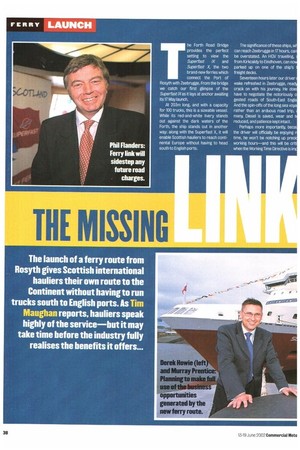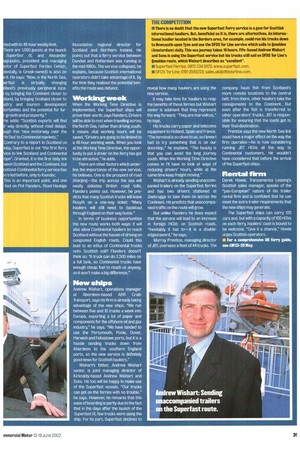The launch of a ferry route from Rosyth gives Scottish
Page 38

Page 39

If you've noticed an error in this article please click here to report it so we can fix it.
international hauliers their own route to the Continent without having to run trucks south to English ports. As Tim Maughan reports, hauliers speak highly of the service—but it may take time before the industry fully realises the benefits it offers... The Forth Road Bridge provides the perfect setting to view the Superfast IX and Superfast X, the two brand-new ferries which connect the Port of Rosyth with Zeebrugge. From the bridge we catch our first glimpse of the Superfast IX as it lays at anchor awaiting its 17 May launch.
At 203m long, and with a capacity for 100 trucks, this is a sizeable vessel. While its red-and-white lrvery stands out against the dark waters of the Forth, the ship stands out in another way: along with the Superfast X, it will enable Scottish hauliers to reach continental Europe without having to head south to English ports. The significance of these ships, w can reach Zeebrugge in 17 hours, ca be overstated. An HGV travelling, from Kirkcaldy to Eindhoven, can no parked up on one of the ship's freight decks.
Seventeen hours later our driver wake refreshed in Zeebrugge, rea crack on with his journey. He doe have to negotiate the notoriously c gested roads of South-East Engle And the spin-offs of the long sea voya rather than an arduous road trip, many. Diesel is saved, wear and t reduced, and patience kept intact.
Perhaps more importantly, beca the driver will officially be enjoying r time, he won't be notching up preci working hours—and this will be crrti when the Working Time Directive is im led with its 48-hour weekly There are 1,000 guests at the launch Superfast IX, and Alexander agopulos, president and managing ctor of Superfast Ferries (which, dentally, is Greek-owned) is also on rd. He says: "Now, in the North Sea, erfast is virtually changing Hand's previously peripheral locaby bringing the Continent closer to tland, by bringing Scotland closer to stry and tourism development ortunities and the potential for furr growth and prosperity."
He adds: "Scottish exports will find ir way directly, without road delays* ugh this 'new motorway over the ‘th Sea' to Continental markets." Contrary to a report in Scotland on day, Superfast is not 'the first ferry vice to link Scotland and Continental no". Granted, it is the first daily link ween Scotland and the Continent, but atland-Continental ferry service has n tried before, only to founder.
This is an important point, and one lost on Phil Flanders, Road Haulage Association regional director for Scotland and Northern Ireland. He points out that a ferry service between Dundee and Rotterdam was running in the mid-1980s. The service collapsed, he explains, because Scottish international operators didn't take advantage of it. By the time they realised the potential benefits the route was defunct.
Working week
When the Working Time Directive is implemented, the Superfast ships will prove their worth, says Randers. Drivers will be able to rest when travelling across the North Sea, rather than driving south. It means vital working hours will be saved. "Drivers are going to be limited to a 48-hour working week. When you look at the Working lime Directive, the opportunity to put a driver on the ferry has got to be attractive," he adds, There are other factors which underline the importance of the new service, he believes. One is the prospect of road charging—the trip across the sea will neatly sidestep British road tolls, Flanders points out. However, he predicts that many Scottish trucks will leave Rosyth on a one-way ticket: "Many hauliers will still need to backload through England on their way home."
In terms of business opportunities the new route works both ways: it will also allow Continental hauliers to reach Scotland without the hassle of driving on congested English roads. Could this lead to an influx of Continental trucks onto Scottish soil? Flanders doesn't think so: "A truck can do 2,500 miles on a full tank, so Continental trucks have enough cheap fuel to reach us anyway, so it won't make a big difference."
New ships
Andrew Wishart, operations manager at Aberdeen-based ARR Crab Transport, says his firm is already taking advantage of the new ships. "We run between five and 10 trucks a week into Europe, exporting a lot of paper and components for the offshore oil and gas industry," he says. "We have tended to use the Portsmouth, Poole, Dover, Harwich and Felixstowe ports, but it is a hassle sending trucks down from Aberdeen to the southern England ports, so the new service is definitely good news for Scottish hauliers."
Wishart's father, Andrew Wishart senior, is joint managing director of Kirkcaldy-based Andrew Wishart and Sons. He too will be happy to make use of the Superfast vessels. "Our trucks can get on the ferries with no trouble," he says. However, he remarks that this ease of boarding is partly due to the fact that in the days after the launch of the Superkist 1X, few trucks were using the ship. For its part, Superfast declines to reveal how many hauliers are using the new service.
It may take time for hauliers to reap the benefits of these ferries but Wishart senior is adamant that they represent the way forward. "They are marvellous," he says.
His trucks carry paper and telecoms equipment to Holland, Spain and France. "The terminal is so close to us, so I knew I had to try something that is on our doorstep," he explains. "The beauty is that you can avoid the long journey south, When the Working Time Directive comes in I'll have to look at ways of reducing drivers' hours, while at the same time keep freight moving."
Wishart is already sending unaccompanied trailers on the Superfast ferries and has two drivers stationed at Zeebrugge to take them on across the Continent. He predicts that unaccompanied traffic on the route will grow.
But unlike Flanders he does expect that the service will lead to an increase in foreign HGVs on Scottish roads. "Inevitably it has to—it is a doubleedged sword," he says.
Murray Prentice, managing director of JBT, oversees a fleet of 44 trucks. The
company hauls fish from Scotland's more remote locations to the central belt; from there, other hauliers take the consignments to the Continent. But even after the fish is transferred to other operators' trucks, JBT is responsible for ensuring that the loads get to their final destination.
Prentice says the new North Sea link could have a major effect 011 the way the firm operates—he is now considering running JBT HGVs all the way to Continental customers. He wouldn't have considered that before the arrival of the Superfast ships.
Rental firm
Derek Howie, Transamerica Leasing's Scottish sales manager, speaks of the "pan-European" nature of his trailer rental firm and is confident that he can meet the extra trailer requirements that the new ships may generate.
The Superfast ships can carry 120 cars and, but with a capacity of 100 HGVs on each ferry, hauliers' cash is bound to be welcome. "Give it a chance," Howie urges Scottish operators.
• For a comprehensive UK ferry guide, see CM23-29 May.




















































































































































